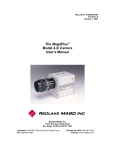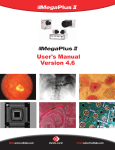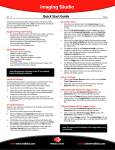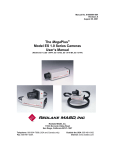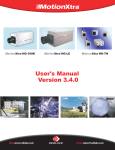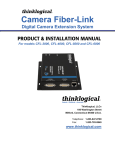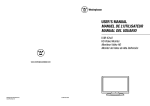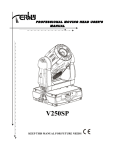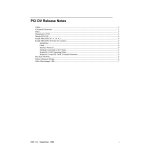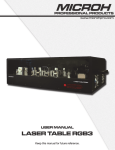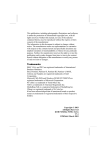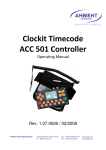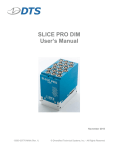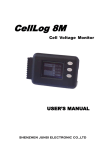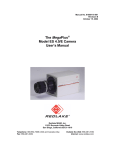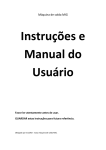Download MegaPlus
Transcript
MegaPlus USER’S MANUAL MODEL 1.6i MODEL 1.6i/AB MODEL 1.6i/TEC MegaPlus USER’S MANUAL MODEL 1.6i MODEL 1.6i/AB MODEL 1.6i/TEC Model 1.6i RECORD OF MANUAL REVISIONS User’s Manual – Supports 1.6i Imagers (PN 91000053-003A) Revision Date A May 15, 2001 ECO No. Initials Comments Converted to Redlake MASD, Inc. and general corrections NOTICE The information in this manual is for information purposes only and is subject to change without notice. Redlake MASD, Inc. makes no warranty of any kind with regard to the information contained in this manual, including, but not limited to implied warranties of merchantability and fitness for a particular purpose. Redlake MASD, Inc. shall not be liable for errors contained herein nor for incidental or consequential damages from the furnishing of this information. No part of this manual may be copied, reproduced, recorded, transmitted, or translated without the express written permission of Redlake MASD, Inc. FCC STATEMENT !WARNING! This equipment generates, uses and can radiate radio frequency energy and, if not installed and used in accordance with the instruction manual, may cause interference to radio communications. It has been tested and found to comply with the limits for a Class “A” computing device pursuant to Subpart B of Part 15 of the FCC Rules and VDE 0871 Class “B”, which are designed to provide reasonable protection against such interference when operated in a commercial environment. Operation of this equipment in a residential area is likely to cause interference, in which case the user, at his own expense, will be required to take whatever measures may be required to correct the interference. This device complies with Part 15 of the FCC rules and VDE 0871. Operation is subject to the following two conditions: (1) this device may not cause harmful interference and (2) this device must accept any interference received including interference that may cause undesired operation. TABLE OF CONTENTS CHAPTER 1 INTRODUCTION Introduction ................................................................................................................. 1.1 How to use this Manual .............................................................................................. 1.2 Warranty ..................................................................................................................... 1.3 Precautions .................................................................................................................. 1.4 CHAPTER 2 COMPONENTS AND CONNECTIONS Camera ........................................................................................................................ 2.1 Camera Rear Panel ..................................................................................................... 2.2 Cables .......................................................................................................................... 2.3 Hardware Setup ........................................................................................................... 2.4 Routine Maintenance .................................................................................................. 2.5 CHAPTER 3 CAMERA OPERATION Introduction ................................................................................................................. 3.1 Serial Interface Protocol ............................................................................................. 3.2 Control Commands ..................................................................................................... 3.3 Query Commands ....................................................................................................... 3.13 CHAPTER 4 INTERFACE SPECIFICATIONS Digital Interface Connector ........................................................................................ 4.1 Cable Descriptions ...................................................................................................... 4.4 Sensor Specification ................................................................................................... 4.7 Frame Rate .................................................................................................................. 4.8 Timing Waveforms ..................................................................................................... 4.9 Specifications .............................................................................................................. 4.12 CHAPTER 1. INTRODUCTION INTRODUCTION HOW TO USE THIS MANUAL WARRANTY PRECAUTIONS INTRODUCTION The Redlake MASD, Inc. MEGAPLUS Camera is a high resolution solid-state camera designed for scientific and industrial imaging applications. The system consists of a DC powered camera head with a 68-pin digital interface. There are no manual user controls on the camera, however the camera is operated by commands sent through a serial communication link. The camera is configured with either an RS-232 or RS-422 serial communications command input. The operation of the MEGAPLUS Camera is very similar to the operation of a 35mm film camera. In a film camera the film is exposed by opening the shutter for a specific amount of time. The shutter then closes and the film is advanced to the next frame. In the MEGAPLUS Camera, a built-in electromechanical shutter is used the same way. The shutter opens exposing the sensor, then closes while the image captured by the sensor is sent to a frame store device. The shutter in the MEGAPLUS Camera can be controlled internally or externally. The camera features a high resolution Charge Coupled Device (CCD) array containing 1534 (H) x 1024 (V) light sensitive elements (pixels). These pixels are 9.0 microns square and have a center-to-center spacing of 9.0 microns (100% fill ratio). In the 1.6i/AB model the fill ratio is reduced to 70%. The equal horizontal and vertical geometry simplify measurements taken with the camera. The benefit of having a 100% fill ratio is reduced aliasing, improved subpixel accuracy, and a 100% light sensitive area. The camera has an 10-bit digital video output containing 1024 levels of gray for each pixel. Exposure is adjustable from 20 milliseconds to 100 seconds in 1 millisecond increments using the internal exposure control. Longer exposure times are possible using an external exposure control signal. The image degrades with longer exposure times because of dark current buildup. If you order the 1.6i/TEC, maximum exposure times are significantly increased. The Thermo Electric Cooling of the sensor decreases dark current levels permitting longer exposure times. The camera can be triggered asynchronously to capture high speed events. Separate exposure and readout cycles can be achieved by using a pulsed illumination light source such as a strobe. An external strobe flash unit can be synchronized through a BNC connector on the rear panel of the camera. This dramatically improves picture quality when the object being photographed is in motion. The MEGAPLUS Camera is ruggedly designed and can accommodate moderate amounts of shock and vibration. Gaskets protect the camera’s interior components from dust, contaminants and EMI. 1.1 HOW TO USE THIS MANUAL CHAPTER 1: INTRODUCTION Chapter One contains an introduction to the MEGAPLUS Camera, a section describing the Users Manual, a table of contents, a Warranty statement and some general precautions to use when operating this product. CHAPTER 2: COMPONENTS AND CONNECTIONS Chapter Two explains the function of the controls and connectors of the MEGAPLUS Camera. CHAPTER 3: CAMERA OPERATION Chapter Three is intended to give the user some insight into how to choose the correct mode of operation for the MEGAPLUS Camera. The correct mode of operation is defined as what will get you the imaging results you are looking for. CHAPTER 4: INTERFACE SPECIFICATIONS Chapter Four covers the specifications of the MEGAPLUS Camera. The intent is to give the end user the interface information they require to use the camera. 1.2 WARRANTY NEW EQUIPMENT WARRANTY REDLAKE MASD, INC. MEGAPLUS CAMERA REDLAKE MASD, INC., WARRANTS THIS MEGAPLUS CAMERA AND ACCESSORIES MANUFACTURED BY REDLAKE MASD, INC., TO FUNCTION PROPERLY FOR ONE YEAR FROM THE DATE OF SHIPMENT. Redlake agrees to perform the following equipment warranty services in the United States. 1. Repair service: If shipped to us, repairs will be made at no charge. 2. Parts replacement: Replacements parts installed under warranty will be provided at no charge. THIS WARRANTY DOES NOT APPLY UNDER THE FOLLOWING CONDITIONS: Failure to operate the MEGAPLUS Camera in accordance with Redlake’s written instructions, including environmental specifications listed in the User’s Manual. If there is evidence of the MEGAPLUS Camera being subjected to accidental damage, misuse or abuse. If the MEGAPLUS Camera has been repaired or tampered with by persons other than Redlake personnel, customer personnel trained by Redlake or without permission of Redlake. Shipping damage is not covered by this warranty. The purchaser has the responsibility to place a claim of damage in shipment with the carrier. REDLAKE MASD, INC. MAKES NO OTHER WARRANTIES, EXPRESS, IMPLIED, OR OF MERCHANTABILITY FOR THIS EQUIPMENT. IF THIS MEGAPLUS CAMERA DOES NOT FUNCTION PROPERLY DURING THE WARRANTY PERIOD, REDLAKE WILL REPAIR IT WITHOUT CHARGE ACCORDING TO THE TERMS STATED ABOVE. REPAIR WITHOUT CHARGE IS REDLAKE’S ONLY OBLIGATION UNDER THIS WARRANTY. REDLAKE WILL NOT BE RESPONSIBLE FOR ANY CONSEQUENTIAL OR INCIDENTAL DAMAGES RESULTING FROM THE SALE, USE OR IMPROPER FUNCTIONING OF THIS EQUIPMENT EVEN IF LOSS OR DAMAGE IS CAUSED BY THE NEGLIGENCE OR OTHER FAULT OF REDLAKE. REDLAKE and MEGAPLUS are trademarks. Copyright Redlake MASD, Inc., 2001 1.3 PRECAUTIONS CAUTION A laser beam focused on the sensor, either directly or by reflection, can cause permanent damage to the sensor. Any laser powerful enough to produce localized heating at the surface of the sensor will cause damage, even if the camera power is off. A sensor damaged by laser light is not covered by the warranty. OPERATING TEMPERATURE The MEGAPLUS CAMERA is designed to operate satisfactorily in an environment where the ambient temperature is between 0 and 35 degrees Centigrade (32 and 95 degrees Fahrenheit), and there is no water condensation present. STORAGE Do not store the equipment in an area where the temperature will drop below -25 degrees or exceed 80 degrees Centigrade (-13 to 176 degrees Fahrenheit). Do not allow moisture to condense on the system. SHIPPING When shipping, use the shipping carton in which the unit was originally delivered. Do not ship the equipment in a cargo area where the temperature will drop below -25 degrees or exceed 80 degrees Centigrade (-13 to 176 degrees Fahrenheit). Do not allow moisture to condense on the system. 1.4 CHAPTER 2. CONTROLS AND CONNECTORS CAMERA CAMERA REAR PANEL CABLES HARDWARE SETUP ROUTINE MAINTENANCE CAMERA MOUNTING THE CAMERA The camera head has four threaded screw holes for mounting, two on the bottom and two on the top of the camera body. All holes accept 1/4-20 threaded screws. In most situations the camera is attached to a tripod via the mounting point on the bottom of the camera head. It is a good practice to mount the camera head on the tripod before attaching a lens to the camera. ATTACHING THE LENS The MEGAPLUS Camera can be purchased with either a C-mount or F-mount lens adapter. If your camera is equipped with an F-mount lens adapter, insert the lens into the locking ring, and rotate the lens counterclockwise until it clicks into position. Hold the release button down as you rotate the lens clockwise to remove the lens. If your camera is equipped with a C-mount lens adapter, screw the lens clockwise into the adapter until you are no longer able to turn the lens with light pressure. See Figure 2.1. Figure 2.1 2.1 CAMERA REAR PANEL The mating connector for the DC power input is made by LEMO FGG.0B.302.CLADxx LEMO (800) 444-5366 Figure 2.2 •••••••••••••••••••••••••••••••••• •••••••••••••••••••••••••••••••••• DIGITAL INTERFACE This is a 68-pin, high density, dual row, D type connector that interfaces the MEGAPLUS Camera to a frame grabber board and serial communication interface for camera control. The frame grabber board processes and displays video from the camera. A complete technical description of the connector and the signals that it carries is contained in Chapter Four of this manual. STROBE OUTPUT The leading edge of this output signal can be used to fire a strobe light. This output signal is TTL compatible and can drive a 50 ohm load. A strobe light with a flash duration of less than 1 millisecond is useful for capturing images of fast moving objects. DC POWER INPUT This two pin connector is the power input for the camera. The power supply voltage should be between 12 and 28 volts DC measured at the connector on the camera rear panel. The current draw is a maximum of 1.1 amps for the TEC camera model, and .8 amps for the other camera models. WARNING Reversing the polarity of the DC voltage input or voltage levels in excess of 30 volts may permanently damage the camera. 2.2 CABLES There are two different cables available to connect the MEGAPLUS Camera to your computer. See Figure 2.3. Figure 2.3 68-pin connector mates with camera 68-pin connector mates with camera For use with RS232 cameras only For use with RS-422 cameras only Female 9-pin Male 68-pin D-subminiature connector mates with mates with computer Frame Grabber RS-232 I/O port Male 68-pin connector mates with Frame Grabber that has an RS-422 I/O Port 2.3 HARDWARE SETUP Figure 2.4 COMPONENT HOOKUP DIAGRAM Connect to Strobe Trigger Input (Optional) •••••••••••••••••••••••••••••••••• •••••••••••••••••••••••••••••••••• DC Power Supply Connect to Frame Grabber Board Connect to COM Port (RS-232 Option) CONNECT THE CABLES Install the cables as illustrated in Component Hookup Diagram, Figure 2.4. 2.4 ROUTINE MAINTENANCE There are no user serviceable parts in the camera. Should a malfunction occur the camera must be returned to the factory for repair. The lens should be cleaned according to good photographic practices. This will help keep your camera producing top quality pictures. See Figure 2.5. The camera can be ordered from the factory with an infrared filter installed in the lens mount. If an infrared filter was not ordered originally a piece of clear glass will be installed in place of the filter. The filter or its glass replacement keeps the interior of the camera sealed from dust and should never be removed in other than a class 100 clean room environment. Because of the high resolution of the camera a single particle of dust on the sensor can be noticeable. If you need to use different filters from time to time in your application we recommend that you order the camera with the clear glass installed. The spectral sensitivity can then be changed by exchanging filters on the front of the lens as in 35 mm photography. Figure 2.5 2.5 CHAPTER 3. CAMERA OPERATION INTRODUCTION SERIAL INTERFACE PROTOCOL CONTROL COMMANDS QUERY COMMANDS INTRODUCTION The various 1.6i camera models do not have any manual controls. Camera operation is accomplished by commands sent to the camera through a serial data link from a personal computer. In this chapter we will present the various operating modes of the camera with an explanation of the function followed by the command sequence that must be transmitted by the computer. The control lines to the camera can be configured as an RS-232 or an RS-422 serial data link. The camera is ordered from the factory configured one way or the other. The command syntax is the same in either case. 3.1 SERIAL INTERFACE PROTOCOL SERIAL COMMUNICATIONS PROTOCOL The camera uses a full duplex UART type asynchronous system, using standard nonreturn-to-zero (NRZ) format (one start bit, eight data bits, one stop bit, no parity). The baud rate is fixed at 9600. The character code is based on the ASCII standard. The character flow control protocol is XON/XOFF. XON is assigned DC1 (control-Q) and XOFF is assigned DC3 (control-S). The receiver sends the XOFF character when it wants the sender to pause in sending data and an XON character when it wants the sender to resume. The camera will recognize a command as three command characters, followed by a space bar character, followed by an argument that consists of one or more characters, ended by the carriage return character. The camera responds to a valid command with a carriage return and line feed (CR-LF). The camera will recognize a query as three command characters, followed by the question mark character, then ended by the carriage return character. The camera responds to a query with three command characters, followed by a space bar character, followed by an argument that consists of one or more characters, then ended by the carriage return character. ERROR MESSAGES The camera can respond to an erroneous command or query in one of three possible ways. MESSAGE FROM CAMERA EXPLANATION E-SYNTAX This response is sent if the camera cannot make sense of the command. E-ARG RANGE This response is sent if the command is recognized but the argument is out of range or indecipherable (e.g., an alpha character imbedded in a numeric string). E-XMIT This response is sent if the receiver detects a transmission error such as buffer overflow, parity, or framing. 3.2 CONTROL COMMANDS MODE CONTROL The MEGAPLUS Camera operates in one of three modes: TRIGGER, CONTINUOUS, or CONTROL. The mode of operation is selected by the mode command. The mode command’s fourth option, PARALLEL INTERFACE, delegates mode selection to three control lines, MC0 - MC2, input through the Digital Interface Connector. TRIGGER Each exposure is started by a signal connected to the EXPOSE input pins of the “Digital Interface” connector on the rear panel of the camera. The Exposure command sets the exposure time and indirectly the frame rate. The EXPOSE input sets the start time for each frame of video. When the trigger signal lasts longer than the combined exposure and readout time the camera will continue to take exposures until the trigger signal goes away. The Trigger mode of operation is used to capture a single picture or sequence of pictures. If the object that you are trying to capture is fast moving, a strobe light may be used to freeze the action. The short flash duration (sometimes less than 50 microseconds) of a strobe is the key to minimizing blur caused by speedy subjects. The Strobe Output on the rear panel of the camera can be used to start the strobe flash. CONTINUOUS The Continuous mode of operation is useful when the operator wishes to monitor an ongoing event. The camera will repeatedly take pictures as fast as the exposure time selected allows. The Exposure command sets the exposure time and indirectly the frame rate. Each new exposure starts as soon as the previous image has been transferred to the camera output by the camera electronics. 3.3 CONTROL COMMANDS CONTROL The start and exposure time of each picture is controlled directly by the user. Control is accomplished by the EXPOSE input pins in the “Digital Interface” connector on the rear panel of the camera. The exposure time is equal to the time the EXPOSE input signal is true. TYPE IN: MDE xx RESPONSE CR-LF MDE? MDE xx EXPLANATION Sets the Mode as determined by the argument TR, CS, CD, PI Queries the current mode setting. Means the mode is set as indicated. SAMPLE COMMANDS WITH ARGUMENTS: MDE TR Sets the mode to Trigger. MDE CS Sets the mode to Continuous. MDE CD Sets the mode to Control. 3.4 CONTROL COMMANDS SHUTTER The MEGAPLUS Camera may be operated with the shutter on or off. When the shutter is OFF, the shutter blades can be locked open or closed. The shutter is controlled by the SHE command in the CONTINUOUS, CONTROL and TRIGGER modes of operation. When the shutter is ON, the exposure time is set by the exposure command for both the CONTINUOUS and TRIGGER modes of operation. When the camera is operated in the CONTROL mode, the exposure lasts for as long as the EXPOSE input to the camera is “true”. The shutter should be turned off with the blades open only if you are working in a darkened area with a light source that is flashed. The camera is always gathering light even as an image is being read from the sensor. If there is light on the subject between exposures, use the shutter to prevent image smear. If you need to acquire a dark current frame, turn the shutter off with the blades closed and transfer a frame. TYPE IN: RESPONSE EXPLANATION SHE xx CR-LF Enables or disables the shutter as determined by the argument ON, FO, or FC SHE? SHE xx Queries the current shutter setting. Means the shutter is enabled or disabled as indicated. SAMPLE COMMANDS WITH ARGUMENTS: SHE ON Enables the shutter. SHE FO Disables the shutter and locks it in the open position. SHE FC Disables the shutter and locks it in the closed position. 3.5 CONTROL COMMANDS EXPOSURE This command sets the exposure time of the camera in increments of one millisecond. The exposure times can be any value between one millisecond and one hundred seconds. This exposure time setting effects the CONTINUOUS and TRIGGER modes only. The maximum frame rate is directly related to exposure time. The maximum frame rate with the exposure set for 50 milliseconds is 4.1 frames per second. For an exposure time of 500 milliseconds the fastest frame rate becomes 1.4 frames per second. Frame Rate = 1/(183.3 milliseconds + exposure time + shutter transition time) When your application involves low light levels and a subject that is not moving, exposure times of more than one second may be necessary. As you push the exposure time beyond one second, you may notice that image quality deteriorates. This is caused by sensor dark current accumulating over time. The CONTROL mode allows you to extend the exposure time beyond 100 seconds but you should understand that picture quality degrades with the longer exposure times. The 1.6i/TEC has much better performance on long exposures because the sensor is cooled. TYPE IN: RESPONSE EXPLANATION EXExxxxxx CR-LF Sets the exposure in one millisecond increments using the argument with a range from 1 to 100000. EXE? EXE xxxxxx Queries the current exposure setting. Means the exposure is set as indicated. SAMPLE COMMANDS WITH ARGUMENTS: EXE 1 Sets the exposure to one millisecond. EXE 100000 Sets the exposure to one hundred thousand milliseconds (100 seconds). 3.6 CONTROL COMMANDS TRIGGER This command enables and sets the polarity of the EXPOSE input on the Digital Interface connector on the rear panel of the camera. TYPE IN: RESPONSE EXPLANATION TRM x CR-LF Sets the EXPOSE input signal in the Digital Connector to positive (TRM P) or negative (TRM N) logic. Either command enables the expose input port pins if they were disabled. TRE x CR-LF TRE 0 forces an exposure. TRE 1 resets the exposure to transfer/idle. Either command disables the EXPOSE input. Use the TRM command to turn the EXPOSE input back on. TRM? TRM P TRM N TRM O TRE? TRE 0 TRE 1 Queries current EXPOSE polarity Means EXPOSE signal is set to positive logic. Means EXPOSE signal is set to negative logic. Means EXPOSE input port has been disabled. This can only occur if TRE 0 or 1 has been executed. Queries current state of TRIGGER command. Means an exposure is taking place. Means the camera is in the transfer frame and then idle state 3.7 CONTROL COMMANDS GAIN The gain of the camera is variable in 2db steps between 0db and 24db. The normal gain position is 6db. 0db halves the gain, 12db multiplies the gain by 2, 18db multiplies the gain by 4 and 24db multiplies the gain by 8. A change in gain of 6db is the same as changing the lens aperture by one f-stop. As you increase the gain of the camera the noise in the picture will increase. By adjusting the camera gain you can optimize the signal to noise ratio and the sensitivity of the camera for your application. TYPE IN: RESPONSE EXPLANATION GAE xx CR-LF Sets the gain control in 2 dB increments. The range of values is 0 to 24, only even numbers are valid. GAE? GAE xx Queries the current gain setting. Indicates that the gain is set to the value given in dB. SAMPLE COMMANDS WITH ARGUMENTS: GAE 0 Sets the camera gain to 0 dB GAE 4 Sets the camera gain to 4 dB GAE 24 Sets the camera gain to 24 dB 3.8 CONTROL COMMANDS BLACK LEVEL The black level control functions much like the brightness control on a television set. To get reasonable results under most circumstances use the BKF or fixed black level. The fixed video black level is set at the factory so that the output video is just above the black clipping level with the lens capped. The black level can be varied over a range of plus or minus 50 percent of peak white video. This adjustment range lets the user compensate for poor lighting. TYPE IN: RESPONSE EXPLANATION BKF CR-LF Sets the black level to an internal fixed value of approximately 50 counts above zero. BKE xxxx CR-LF Sets the black level as determined by the argument with a range from -2048 to 2047. BKE? COMMAND BKE -2048 BKE 0 BKE 2047 BKF Queries current black level setting. Means the black level is at the factory preset level. BKE xxxx Means black level externally set to the value indicated. APPROX. OUTPUT OFFSET -512 COUNTS 0 COUNTS +511 COUNTS NOTE The video will be clipped to 0 counts until it overcomes a negative offset. The video will be offset towards white by a positive offset. 3.9 CONTROL COMMANDS STROBE POLARITY The STROBE OUTPUT on the rear panel of the camera provides a trigger signal for the user’s stroboscopic light source. The polarity of the strobe signal is set by this command. Use the leading edge of the strobe signal as the trigger point because the trailing edge may vary. The strobe output is capable of driving a 50 ohm load. TYPE IN: RESPONSE EXPLANATION STP x CR-LF Sets the polarity of the strobe trigger pulse to positive (STP P) or to negative (STP N). STP? Queries the strobe trigger output polarity STP P Means the strobe output is a high going pulse. STP N Means the strobe output is a low going pulse SAMPLE COMMANDS WITH ARGUMENTS: STP P STP N 3.10 Make the strobe output a high going pulse. Make the strobe output a low going pulse. CONTROL COMMANDS DEFECT CORRECTION Occasionally sensors are not perfect and have some areas that react differently to light. These problem pixels are usually seen as a column that is different in intensity than the immediately adjacent area. It is possible to characterize a sensor identifying the defective columns and then program their locations into the camera at the factory. When defect correction is turned on, the camera replaces the defective areas with information derived from nearby pixels making the defects less noticeable. TYPE IN: RESPONSE EXPLANATION DEF xx CR-LF Enables (DEF ON) or Disables (DEF OF) defect correction. DEF? Queries the state of defect correction. DEF ON Means correction is enabled. DEF OF Means correction is disabled. SAMPLE COMMANDS WITH ARGUMENTS: DEF ON Turns on defect correction. DEF OF Turns off defect correction. RESET TYPE IN: RST RESPONSE CR-LF EXPLANATION Resets the camera to the settings as last saved. Removing and then restoring power to the camera also performs a reset. SAVE TYPE IN: SAV RESPONSE CR-LF EXPLANATION Saves the current camera settings to EEPROM; these settings will be recalled by a RESET or turning the camera power on. 3.11 CONTROL COMMANDS DISPLAY WEDGE Display a linearly increasing 1024 step gray scale with each step being one pixel wide. The pattern rises to white and then resets to black as shown in Figure 3.1 below. This function is useful for verifying the camera’s digital output to a frame grabber. The Wedge Display defaults to off when the power to the camera is turned off. TYPE IN: RESPONSE EXPLANATION WDG ON CR-LF Means the wedge is being displayed. WDG OF CR-LF Means the camera is imaging. WDG ? Queries the state of wedge display. Figure 3.1 3.12 QUERY COMMANDS STATUS QUERY The status query command enables the user to get all the camera operating parameter information with a single command. TYPE IN: STS? RESPONSE EXPLANATION Gives complete camera status with one query. The following parameters are transmitted with a carriage return after each parameter: DEF xx GAE xxx BKE xxxx MDE xx SHE xx EXE xx TRM x TRE x STP x SCP x Shows defect conceal status Shows gain setting Shows black level setting Shows the operating mode Shows the shutter status Shows the exposure time Shows the trigger logic polarity Shows the exposure state Shows the polarity of the strobe pulse Shows communications protocol A TYPICAL REPLY TO STS? WOULD BE AS FOLLOWS: DEF ON GAE 6 BKE 610 MDE CD SHE ON EXE 100 TRM P TRE 1 STP N SCP 232 IDENTIFICATION QUERY This query returns the camera model designation and the version of the firmware installed in the camera. TYPE IN: RESPONSE EXPLANATION IDN? MEGAPLUS Model 1.6i,Vx.xx Queries the camera for model number and firmware version. 3.13 CHAPTER 4. INTERFACE SPECIFICATIONS DIGITAL INTERFACE CONNECTOR CABLE DESCRIPTIONS SENSOR SPECIFICATIONS FRAME RATE TIMING WAVEFORMS SPECIFICATIONS DIGITAL INTERFACE CONNECTOR INTRODUCTION Chapter Four gives you the information needed to interface the MEGAPLUS Camera, Model 1.6i to a frame grabber device. The relationship between the video outputs and the synchronization outputs of the camera are presented in the following order: • DIGITAL INTERFACE CONNECTOR • MODE CONTROL • EXPOSURE TIMING • FRAME TIMING • LINE TIMING • PIXEL TIMING The MEGAPLUS Camera, Model 1.6i is a high resolution black and white still camera presenting a ten bit digital video output. Each frame has 1,534 columns and 1,024 rows of pixels (picture elements) containing valid video data. DIGITAL VIDEO CONNECTOR All the signals referred to in this section are present at the digital interface connector on the rear panel of the camera. Table 1 lists each signal and its pin number. The connector for this port is a 68-pin, high density, dual row, D type connector. This connector is the same as that used for the “SCSI-2 B cable” interface. The connector has .050 pin spacing and a D-type shell that is 2.5 inches long. DIGITAL VIDEO OUTPUTS The digital video output of the camera has ten bits labeled MSB through MSB-9. These signals are output as differential pairs with signal levels conforming to the RS-422 specification. The noninverting part of the differential pair is present on output (+), while the inverting part of the differential pair is present on output (-). 4.1 DIGITAL INTERFACE CONNECTOR MSB is the most significant bit and MSB-9 is the least significant bit in this camera configuration. All frame grabbers designed to work with this and future MEGAPLUS Cameras should be MSB justified. TIMING OUTPUTS There are three timing outputs presented on the Video connector. They are FRAME ENABLE (FRME ENA), LINE ENABLE (LINE ENA) and PIXEL DATA STROBE (PIX DATA STRB). These signals are output as differential pairs with signal levels conforming to the RS-422 specification. The noninverting part of the differential pair is present on output (+), while the inverting part of the differential pair is present on output (-). A signal is true when the (+) line is more positive than the (-) line. CONTROL INPUTS The control input EXPOSE is provided as a means of externally controlling the exposure of the camera. This input is designed to accept RS-422 differential or, for backwards compatibility, single ended TTL. To drive this input differentially connect both the (+) and (-) inputs to an RS-422 driver. When the (+) input is more positive than the (-) input the camera is exposing. When the (+) input is more negative than the (-) input the camera performs a frame transfer and then idles. To drive the EXPOSE input with a single ended TTL signal source, connect one input to a TTL driver and leave the other input floating. If the (+) input (pin 30) is driven then a TTL high will start an exposure or if the (-) input (pin 64) is driven then a TTL low will start an exposure. 4.2 DIGITAL INTERFACE CONNECTOR Table 1 Digital Interface Connector Pinout on Rear of Camera SIGNAL NAME PIN SIGNAL NAME PIN SOURCE GROUND 1 GROUND 35 Camera MSB (+) 2 MSB (-) 36 Camera MSB-1 (+) 3 MSB-1 (-) 37 Camera MSB-2 (+) 4 MSB-2 (-) 38 Camera MSB-3 (+) 5 MSB-3 (-) 39 Camera MSB-4 (+) 6 MSB-4 (-) 40 Camera MSB-5 (+) 7 MSB-5 (-) 41 Camera MSB-6 (+) 8 MSB-6 (-) 42 Camera MSB-7 (+) 9 MSB-7 (-) 43 Camera MSB-8 (+) 10 MSB-8 (-) 44 Camera MSB-9 (+) 11 MSB-9 (-) 45 Camera GROUND 12 GROUND 46 Camera Not used 13 Not used 47 Not used 14 Not used 48 Not used 15 Not used 49 Not used 16 Not used 50 Not used 17 Not used 51 Not used 18 Not used 52 Not used 19 Not used 53 Not used 20 Not used 54 Not used 21 Not used 55 SER CNTRL OUT(+) 22 SER CNTRL OUT(-) 56 Camera SER CNTRL IN(+) 23 SER CNTRL IN(-) 57 User Not used 24 Not used 58 FRME ENA(+) 25 FRME ENA(-) 59 Camera LINE ENA(+) 26 LINE ENA(-) 60 Camera Not used 27 Not used 61 Not used 28 Not used 62 PIX DATA STRB(+) 29 PIX DATA STRB(-) 63 EXPOSE(+) 30 EXPOSE(-) 64 User MC0 31 Not used 65 User MC1 32 Not used 66 User MC2 33 Not used 67 User GROUND 34 GROUND 68 Camera Camera Figure 4.1 34 1 68-PIN RECEPTACLE VIEWED FROM CAMERA’S REAR PANEL 68 35 4.3 CABLE DESCRIPTION REFER TO TABLE 1 FOR CABLE PIN OUT. Figure 4.2 68-pin connector mates with camera For use with RS-422 cameras only Male 68-pin connector mates with Frame Grabber that has an RS-422 I/O Port 4.4 CABLE DESCRIPTIONS Table 2 Interface Cable Pinout for Cable That Mates With 68-Pin Frame Grabber Connector SIGNAL NAME PIN SIGNAL NAME PIN SOURCE GROUND 1 GROUND 35 Camera MSB (+) 2 MSB (-) 36 Camera MSB-1 (+) 3 MSB-1 (-) 37 Camera MSB-2 (+) 4 MSB-2 (-) 38 Camera MSB-3 (+) 5 MSB-3 (-) 39 Camera MSB-4 (+) 6 MSB-4 (-) 40 Camera MSB-5 (+) 7 MSB-5 (-) 41 Camera MSB-6 (+) 8 MSB-6 (-) 42 Camera MSB-7 (+) 9 MSB-7 (-) 43 Camera MSB-8 (+) 10 MSB-8 (-) 44 Camera MSB-9 (+) 11 MSB-9 (-) 45 Camera GROUND 12 GROUND 46 Camera Not used 13 Not used 47 Not used 14 Not used 48 Not used 15 Not used 49 Not used 16 Not used 50 Not used 17 Not used 51 Not used 18 Not used 52 Not used 19 Not used 53 Not used 20 Not used 54 Not used 21 Not used 55 Not used 22 SER CNTRL OUT(-) 56 Do not use Not used 23 SER CNTRL IN(-) 57 Do not use Not used 24 Not used 58 FRME ENA(+) 25 FRME ENA(-) 59 Camera LINE ENA(+) 26 LINE ENA(-) 60 Camera Not used 27 Not used 61 62 Not used 28 Not used PIX DATA STRB(+) 29 PIX DATA STRB(-) 63 EXPOSE(+) 30 EXPOSE(-) 64 User MC0 31 Not used 65 User MC1 32 Not used 66 User MC2 33 Not used 67 User GROUND 34 GROUND 68 Camera Camera Figure 4.3 1 35 34 68 68-pin male D-subminiature connector as viewed at the end of the cable. 4.5 CABLE DESCRIPTIONS Table 3 Interface Cable Pinout for Cable That Mates With PC COM Port SIGNAL NAME Open Camera TX Camera RX Open Camera ground Pin 1 2 3 4 5 SIGNAL NAME Open Connected to pin 8 Connected to pin 7 Open Figure 4.4 9-pin female D-subminiature connector as viewed at the end of the cable. Refer to Table 2 for pin out of 68-pin frame grabber connector and to Table 3 for pin out of cable that mates with computer COM port. 5 9 1 6 Figure 4.5 68-pin connector mates with camera For use with RS-232 cameras only Female 9-pin D-subminiature mates with computer RS-232 I/O port 4.6 Male 68-pin connector mates with Frame Grabber PIN 6 7 8 9 SENSOR SPECIFICATION Imaging Device: Total Pixel clock count: Light-sensitive Pixels: Elements Transferred per Line: Lines Transferred per Frame: Pixel Size: Center-to-Center Pixel Spacing: Active Area: Solid-state charge-coupled device (CCD); front illuminated full frame architecture 1,832,832 (1,776H x 1,032V). 1,570,816 (1,534H x 1,024V). 1,776 pixel clock pulses in each line transfer (1,534 for active video + 242 for sync and blanking) 1032 (Four dark lines at the bottom and four dark lines at the top) 9.0 x 9.0 microns (square format) 9.0 microns, vertical and horizontal 13.8mm(H) x 9.2mm(V) photosensitive area 100% fill factor for Model 1.6i and 1.6i/TEC. 70% fill factor for Model 1.6i/AB Figure 4.6 Sensor Organization VIDEO OUT LINE AT A TIME VERTICAL TRANSFER First pixel 242 UNDEFINED COLUMNS 4 DARK LINE ACTIVE IMAGE AREA 1032 ROWS 1534 (V) x 1024 (H) 4 DARK LINE 1776 COLUMNS 100% FILL FACTOR Last pixel 4.7 FRAME RATE FRAME RATES The frame rate of the camera is the number of images that can be taken per unit time. The camera must transfer a full frame before it is able to make a new exposure and transfer the new frame. The rate depends on both the frame transfer time and the exposure time. FRAME TRANSFER TIME The frame transfer time is a constant. It is the number of pixels in a frame divided by the rate they are clocked out. 1032 lines X 1776 clock intervals per line = Transfer Time 10 MHz = 1,832,832 pixels @ 10 MHz = 183.3 msec FRAME REPETITION RATE The frame repetition rate depends on both the frame transfer time (above) and the exposure time. _______________1_______________________ = Frame Rate (frame transfer time + exposure time + shutter transit time) For exposures that are much shorter than the frame transfer time and when the shutter is off, the frame transfer time dominates the above equation and the frame rate approaches the maximum: 1/ (183.3) ms = 5.46 frames/sec For an exposure time of 50 ms the frame rate becomes: 1/ (183.3 + 50 + 12) ms = 4.1 frames/sec For an exposure time of 500 ms the frame rate becomes: 1/ (183.3 + 500 + 12) ms = 1.4 frames/sec It is important to remember that each line has 1534 active pixels and that there are 1024 lines of valid video data in each frame. The first and last four lines are not light sensitive. 4.8 TIMING WAVEFORMS EXPOSURE TIMING EXPOSE(+) LINE ENA(+) STROBE OUTPUT (Shutter Off) 250 ns to 178 µs 24.2 µs 250 ns to 178 µs 177.6 µs 70 µs typ. FRME ENA(+) 12 millisec 70 µs typ. STROBE OUTPUT (Shutter On) 12 millisec FRME ENA(+) NOTE: EXPOSE Is asynchronous to LINE ENA EXPOSE and STROB TRIG polarity are software controlled 250 ns to 178 µs Fig 4.7 Exposure Timing Wave Forms NOTE The EXPOSE input pulse must be wide enough to be seen by at least one horizontal SYNC. which occurs once every 177.6 µsec. A pulse width of less than 177.6 µsec may be missed. 4.9 TIMING WAVEFORMS FRAME TIMING 1 FRAME FRME ENA(+) LINE ENA(+) 1032 LINES EXPOSUR 4 INVALID DARK LINES 4 INVALID DARK LINES Figure 4.8 Frame Timing (Continuous Mode) The FRME ENA(+) signal is low while the array is exposed. The duration of this low state is variable and includes the user defined exposure time. A complete frame of video data is transferred to the camera outputs while FRME ENA(+) is high. The camera takes 183.3 milliseconds to transfer a complete image from the sensor array to the output. FRME ENA(+) will be low while the camera is idle and while the camera is exposing. The first pixel that is output in the frame transfer sequence is the pixel that belongs in the upper lefthand corner of the video display. Each row of video data is output from left to right and the rows are presented from top to bottom. The last pixel of the frame is placed in the lower right hand corner of the video display. The video is transferred by shifting each row up one row. The top row is shifted into a register that performs the parallel to serial conversion as it outputs the video data. The LINE ENA(+) signal is held high for the time that it takes to output one row of video. The LINE ENA(+) signal has a period of 177.6 µsec and runs continuously even if there is no video to be output. 4.10 TIMING WAVEFORMS LINE TIMING 1 LINE 177.6 µS LINE ENA(+) PIX DATA STB 1776 1 DIGITAL VIDEO TRANSITION PIXEL VIDEO PIXELS 2 INVALID PIXELS 1534 1535 1536 1775 1776 1 TRANSITION PIXEL Fig 4.9 Line Timing LINE ENABLE The LINE ENA signal is the Horizontal Sync for the camera. This signal runs continuously to allow external equipment to “phase lock” with the camera if desired. It is not affected by the camera mode or by any state the camera may be in (idle, exposing, or transferring). When LINE ENA(+) is low, all lines in the sensor are shifted upward in parallel one line. The top line is shifted into the horizontal output shift register. When LINE ENA(+) is high, the information in that horizontal shift register is clocked serially to the camera’s output circuits. Image data is valid only when both FRME ENA and LINE ENA are high, the rest of the time the data are meaningless. PIXEL TIMING PIX DAT STRB(+) is a 10 MHz square wave that runs continuously. This clock drives the circuitry that identifies pixels, counts lines, and synchronizes the internal states of the camera. Valid digital data should be sampled at the rising edge of PIX DAT STRB (+). FIG 4.10 Pixel Clock Timing PIX DAT STRB FRME ENA (+) LINE ENA (+) 25 ns min. 45 ns min. DIGITAL DATA STROBE TRIGGER 70 µs typ 4.11 SPECIFICATIONS VIDEO PERFORMANCE Black Level: Gamma: Scanning: Synchronization: Dynamic Range: Pixel Clock Rate: Frame Rate: NOTE: CAMERA MECHANICAL Housing: Dimensions: F-Mount: C-Mount: Weight: Tripod Mount: Cooling: TEMPERATURE Operating: Clamped to black reference at the start of each line. Unity. Non-Interlaced progressive scan. Internal. Greater than 65 dB. at the input of the A/D Converter. 10 MHz. 5.5 frames/sec. @ strobe illumination 4.1 frames/sec. @ 50 msec exposure time 1.4 frames/sec. @ 500 msec exposure time Frame Rate = 1/(183.3 millisec + exposure time + 12 millisec shutter transition time) All aluminum, gasket sealed case. 4.45"H x 3.90"W x 5.84"L (113.0 x 99.1 x 148.3mm) 4.45"H x 3.90"W x 4.68"L (113.0 x 99.1 x 118.8mm) 3 lbs approx. (1.26Kgs) 4.6 lbs approx. (2.1 Kgs) Model 1.6i/TEC (4)1/4 - 20 threads. Thermo Electric Cooling. Model 1.6i/TEC only Storage: 0 to 35° C (32 to 95° F), non - condensing (Image quality will degrade with increasing temperature) -25 to +80° C (-13 to 176° F), non-condensing. HUMIDITY Operational: Storage: Vibration: Shock: < 80% @ 35° C (95° F) < 40% @ 80° C (176° F) 3G, sinusoidal from 5 to 150 Hz 20G, non-operating 4.12 11633 Sorrento Valley Rd. San Diego, California 92121-1097 800-854-7006 or 858-481-8182 REDLAKE and MEGAPLUS are trademarks. Printed in U.S.A. © Copyright Redlake MASD, Inc. 2001 PN91000053-003 REV. A











































